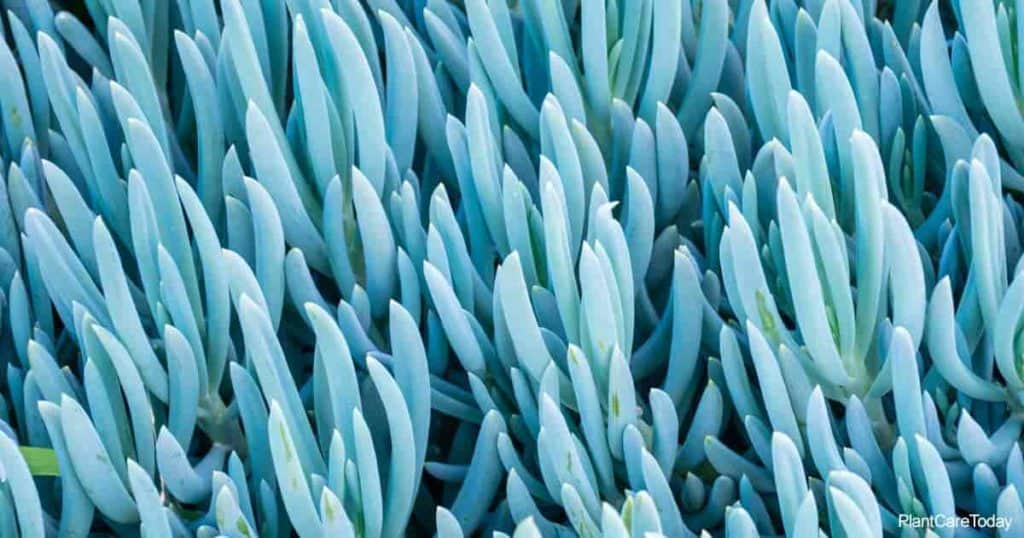Senecio Mandraliscae [Sen-ek-ee-o, Man-druh-LISS-kee] is a dwarf shrub in the family of Asteraceae and a species in the Senecio genus.
This attractive blue-green plant is native to South Africa.

The synonyms used for this plant are:
- Curio Talinoides var Mandraliscae
- Senecio Talinoides
- Kleinia Mandraliscae
- Senecio Talinoides Mandraliscae
- Kleinia Comptonii
The common names for Senecio Mandraliscae plants include:
- Blue Stick Succulent
- Blue Chalk Sticks
- Bluefinger
Other popular Senecio varieties include:
- Senecio rowleyanus – String of Pearls Plant
- Senecio Barbertonicus – Lemon Bean Bush
- Senecio Stapeliiformis – The Pickle Plant
- Senecio serpens – Mini Bluechalk Sticks
- Senecio vitalis – Narrow-leaf Chalksticks
Senecio Mandraliscae Plants Care
Size & Growth
This plant is a spreading succulent producing pencil-like, silver-blue fleshy leaves.
It quickly forms a dense mat of upward curling leaves in the garden.
It grows about 12” – 18” inches tall and 18” – 24” inches wide.
Flowering and Fragrance
This plant produces small white flowers on top of the foliage during summer seasons and early fall.
The flower color of this plant ranges from creamy-white to blue-green.
The bloom time is the summer season.
Light & Temperature
The Blue Chalk Sticks loves to grow under the full sun, but also tolerates light shade.
When growing indoors, place this plant in a room with plenty of sunlight.
Provide partial shade during harsh heat to prevent discoloration.
It is ideal to move the plants outdoors when temperatures continuously stay above 40° degrees Fahrenheit (4° C).
Transfer them back indoors before the first frost.
This plant’s USDA zones of hardiness are 9 – 11.
Watering and Feeding
The water needs of the Bluefinger are moderate during the fall and spring season.
This plant is drought tolerant, but regular watering is tolerated as well.
Keep the soil dry during the winter season to prevent stem rot.
The plant easily adapts to varying growing conditions from drought to harsh heat.
Feed this plant with a water-soluble, balanced fertilizer during the early spring season.
The fertilizer should have equal parts of potassium, phosphorus, and nitrogen.
Avoid over-fertilizing the plant as it might result in weak growth.
Soil & Transplanting
The Blue Chalk Sticks must be grown in a well-draining soil mixture.
Use a succulent soil mix or a cactus mix to enhance its growth and reduce the chances of rot.
The pH level of the soil should be mildly alkaline or mildly acidic; however, the plant is also tolerant of poor soils.
Grooming and Maintenance
Prune the dead and wilting stalks and flowers to maintain a tidy appearance of the plant.
These species are prone to getting leggy, especially when growing in pots, which is why trimming it each year is recommended.
This process must be done during the later summer season.
Be sure to remove and reroot the plants after three to four years during the mild months.
How to Propagate Blue Chalk Sticks
The propagation of this plant is done with seeds or cuttings.
The easy way is to use cuttings during the summer.
Take the cuttings from the Bluefinger and leave them for two weeks to dry.
Be sure to use a sharp, sterile knife or scissors to take the cuttings and remove the leaves.
Plant it in well-draining, loose soil and water it every time the soil gets completely dry.
When using seeds, make sure the temperature is warm.
- Use a seed warmer or grow light if needed.
- Seeds must be sown in well-draining soils.
- Water properly when the soil is dry.
- The germination process usually takes two to three weeks, depending on the conditions.
- Once the roots are established, transplant them in their permanent positions in the garden or a bigger container.
Blue Chalk Sticks Pest or Diseases
This plant is generally disease and pest free, like most of the succulent plants.
Be on a lookout for little white succulent mealybugs as they might cause molds on leaf surfaces.
If leaf drop or yellow spots are seen on the plant, it might be scales infestation.
Use rubbing alcohol-dipped cotton swab or soft cloth to wipe the mealybugs and scales off the plant.
Bacterial or fungal rots might cause dropped or wilting leaves.
Provide more light and increase watering to resolve this problem.
Prune the damaged foliage to maintain the appearance of the plant and to prevent further infestation or damage.
This plant is resistant to deer and rabbits and is also fire resistant.
Blue Chalk Senecio Uses
This plant forms a dense mat ground cover and works well in a rock garden, succulent garden, in borders, lawn edges, and median strips.
The blue-green shade of this plant makes it an excellent contrast to Phormiums, Aeoniums, and mixed with other succulent plants.
It may be used as a single plant in a container and also in mixed containers.
It is also suitable for xeriscape plantings, in Mediterranean climates, and adds a distinctive touch to other floral arrangements.
